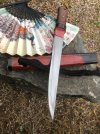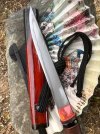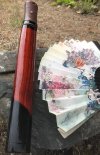- Joined
- Apr 25, 2020
- Messages
- 21
Hello, just wanted to introduce myself and show an example of my work. I am new to the forum. Been making seriously for about 3 years, informally for about 25 years... This one I call Oni Doshi. W2 steel, slight uchizori with iorimune, damascas hamidashi style tsuba, african padauk saya, water buffalo horn kurikata, fuchi, and koiguchi. Copper habaki, seppa and mekugi with DoHi patina, kangaroo leather tsukaito. Please let me know what you think!





